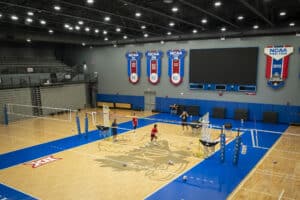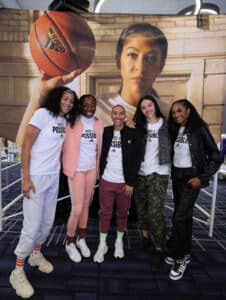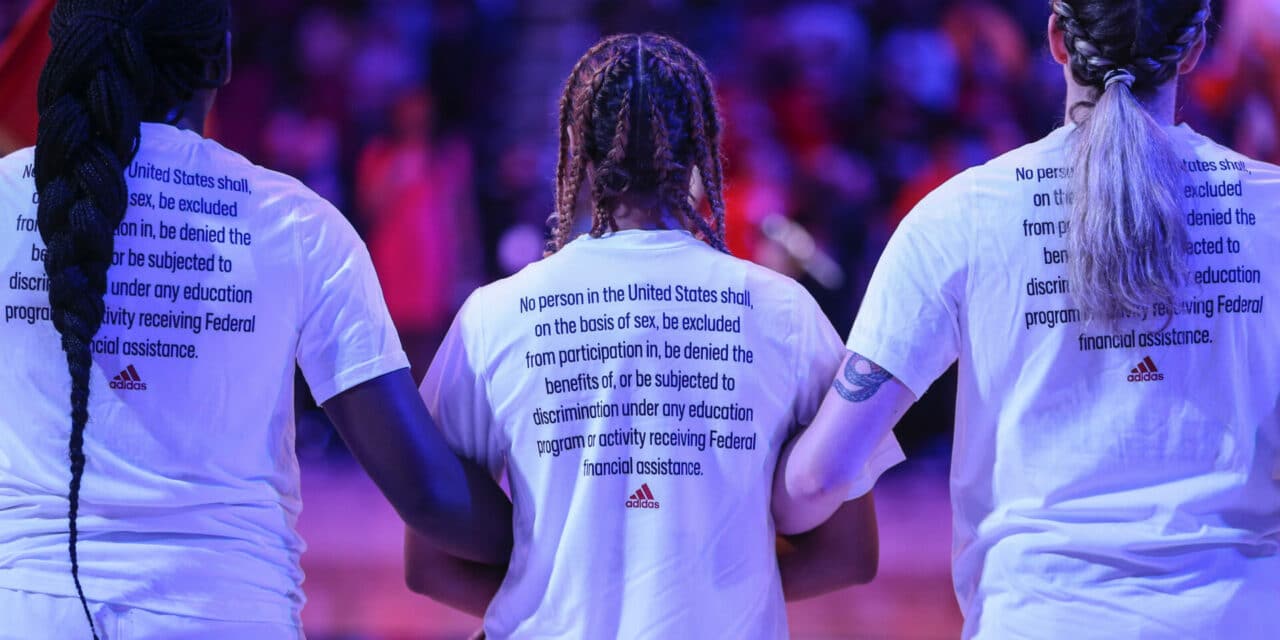Living The Dream: Louisville Cardinals basketball players prepare for the Sweet 16 round of the NCAA tournament at Intrust Bank Arena in Wichita. They’re wearing Adidas “More Is Possible” tees as part of the company’s NIL announcement that also celebrates the 50th anniversary of Title IX. (Travis Heying/AP Images for Adidas)
Title IX was a game changer for women’s athletics, paving a path for the development of specific venues for women’s athletics at the college level and beyond. The landmark law signed by President Richard M. Nixon on June 23, 1972, didn’t mention sports when it was drafted by Sen. Birch Bayh of Indiana. In one sentence, 37 words, it was designed to foster gender equality in education:
No person in the United States shall, on the basis of sex, be excluded from participation in, be denied the benefits of, or be subjected to discrimination under any education program or activity receiving Federal financial assistance.
Prior to 1972, there were quotas on women in the classroom. Just five percent of spots were reserved for female students. Today, about
60 percent of women are going to college.
The word “activity” in the Title IX wording is what opened the door for women’s sports.
Before he died in 2019, Bayh said legislators almost didn’t put “activity” into the wording. They left it as a “catch-all” Bayh recalled, “Let’s just leave it in, you never know.”
The decision paved the way for Olympic excellence, put women in line for sports and venue leadership positions and led to the creation of professional women’s sports leagues at venues across North America including the Women’s National Basketball Association (1997), National Women’s Soccer League (2013) and the Premier Hockey Federation (2015).
Combined, women’s professional sports are projected to become a $1 billion industry in the next few years, according to the 2020 Deloitte TMT Predictions report, in large part due to million-dollar broadcast deals, lucrative sponsorships and live event revenue. When it started nine years ago, the NWSL streamed games for free on YouTube for 1,000 viewers. Recently, the league signed a seven-figure broadcast deal with CBS and Amazon-owned streaming platform Twitch. In 2019, the dozen teams in the NWSL drew an average attendance of 7,300 per game, according to league data.

STAYING CURRENT: A rendering of the new 11,500-seat stadium for the NWSL’s Kansas City Current, scheduled to open in 2024. Generator Studio is the project architect.
In October, construction begins on one of the very first stadiums built for professional women’s soccer in the U.S. The $118 million facility for the NWSL’s Kansas City Current will have 11,500 seats and follows the opening in June of the team’s $18 million training complex.
The stadium is set to open in 2024. In addition, the WNBA Seattle Storm is planning a $60 million, 50,000 square-foot training facility scheduled to open in 2024. It’s big business and Title IX made it possible by leveling the playing field for women’s sports from elementary school through college because athletics were considered a critical piece of an institution’s educational program covered by the federal law.
“Title IX to me means empowerment,” said Lauren Dooley, star volleyball player for University of Kansas and a member of the inaugural Adidas roster of 15 female student athletes receiving NIL deals. The NCAA’s new program allows college athletes to be financially compensated when their name, image or likeness are used in marketing endeavors. “Women have the same opportunities, even more nowadays. As the years keep going, sports keep growing and women keep growing. Empowerment and growth are what Title IX means to me.”
The law applies to several areas of education: athletics, academics, sexual assault and violence on campus, employment, discrimination, admissions, retaliation and financial assistance with tuition. Title IX doesn’t necessarily require cutting any sports, men’s or women’s. It does allow schools to make choices for how to structure their athletic programs as long as schools don’t discriminate. Oversight is handled by the U.S. Department of Education Office for Civil Rights.
Legislation says women’s and men’s teams are to be treated equally under Title IX. To monitor and measure compliance, the Equity in Athletic Disclosure Act (EADA) was passed in 1994. The federal law requires colleges and universities to provide annual equity reports that track participation, coaching staff and salaries, revenues and expenses, including recruiting and game-day costs.
Resulting accountability and transparency has advanced women’s athletics, according to Dr. Amy Wilson, the NCAA’s managing director of inclusion.
“You can just see as college women’s sports improved the impact that it had on our 1996 Olympic performance,” Wilson said., referencing the year U.S. women’s teams won gold for basketball, soccer, softball and gymnastics. “You see it all rising together.”

Xtream Women’s Sports: Xtream Arena in Coralville, Iowa, just unveiled a Title IX statue outside its entrance. The venue is home to the University of Iowa’s women’s volleyball team and will be the home of the newly sanctioned Iowa Girls High School Athletic Union state wrestling championships in February.
According to an “NCAA Title IX at 50” report released in June and authored by Wilson on the state of women’s athletics, the number of women competing at the highest level of college athletics continues to rise along with an increasing funding disparity between men’s and women’s sports programs.
The report found 47.1 percent of participation opportunities were for women across Division I programs in 2020 compared with 26.4 percent in 1982. Going back to high school athletics, the report found that participation numbers for girls still don’t reach that of boys in the 1971-72 school year. At the time, participation opportunities for boys measured at nearly 3.7 million, more than 264,000 higher than girls had as recently as 2019.
According to the “NCAA Title IX at 50” report, a growing number of women are finding careers as coaches and conference commissioners. Women hold 25 percent of all NCAA head coaching and athletic director positions. In 2019-2020, of the 141 conference commissioner positions, 44 were held by women including five minority women.
“The thing that was most important is it broke down barriers in education,” Wilson said. “When you look at the athletics part of this and the opportunities given to women to just see what their potential is in a pool, on a court, on a field, it’s amazing that athletic experience positions women to be ready for positions of power and leadership. Sports do that better than most forums or experiences we have growing up.”
Some schools are ahead of the curve at creating ways to expand participation in women’s sports including the volleyball programs at KU and the University of Iowa, which both have topline facilities, providing coaches and players with greater control over scheduling games and practices, as well as a prime recruiting tool.
Wilson received her Ph.D at the University of Iowa and cites Dr. Christine Grant as an influencer. Grant was still a doctoral student when she was named the first athletic director for women’s athletics at the University of Iowa in 1973, a position she held until 2000. While Grant was a student at Iowa, women had to pay to compete on club teams. When she became coach of the women’s golf club, the team couldn’t practice on local courses without paying, so they practiced with wiffle balls. When the university was planning a new recreation building, she discovered there were no women’s restrooms or locker rooms in the initial design.
Grant pushed back.
“I’m sure that was the trigger that made me a feminist,” Grant said in 2009, according to Iowa magazine (she died in 2021). “That blew me away.” Grant became a vocal advocate for Title IX and a nationally recognized leader on gender equality in sports. The programs she launched at Iowa are the foundation of women’s athletics at the university, said Jason Anderson, general manager of Xtream Arena in Coralville, Iowa, a few miles north of the Iowa City campus. The venue is part of the OVG360 facility management group, which is owned by VenuesNow parent company Oak View Group.

Rock Chalk Volleyball: The Kansas Jayhawks play volleyball at Horejsi Family Volleyball Arena, which opened in September 2019. The $12 million venue has three courts, including practice space. (Aiden Droge/Kansas Athletics)
The 5,100-capacity venue opened in 2020 as home to Iowa women’s volleyball and serves as a hub for the Iowa Girls High School Athletic Union state volleyball championships in November, which had been in Cedar Rapids for three decades. The arena will be the first home of the newly sanctioned IGHSAU state wrestling championships, a two-day tournament in February. Developing stronger players at the high school level increases the recruitment pool for college programs, such as Iowa’s new women’s wrestling program.
“This town is such a big supporter of athletics that we think it will take off, especially with the quality of athletes women’s wrestling coach [Clarissa] Chung is getting,” Anderson said. “She’s pulling all of the best wrestlers, leading the forefront from the Division I power conference side.”
To celebrate Title IX and the establishment of Iowa women’s athletics 49 years ago, a statue was to be unveiled in front of Xtream Arena in early September. The Big Ten Conference, of which Iowa is a member, is taking steps to advance women’s athletics as well. For the first time this year, the Big Ten hosted official volleyball media days in August — a preseason ritual typically reserved for football or men’s basketball. The event, held at the Big Ten Network studios in Chicago, featured players and coaches from all 14 women’s volleyball teams.
At Kansas, Paul Pierce II, associate athletic director for inclusion excellence, said the school has several events planned to shine a spotlight on Title IX.
“Our country was able to move forward with creating inclusive legislation, but the part I always remember, and remind folks of, was that it was only 50 years ago,” said Pierce, not to be confused with former NBA star and KU alum Paul Pierce. “It wasn’t that long ago when access and opportunity for women in education — and more identifiably women in sports — wasn’t something that was top of mind. For us at Kansas, we are looking forward to celebrating Title IX the entire academic year.”
The university currently has 25 initiatives planned through June 2023, including the creation of a coaches’ playbook that serves as a resource guide for generating inclusive conversations and awareness-building activities within sports programs. Plus, on Nov. 2, a Title IX celebration match is scheduled against archrival Kansas State at the Horejsi Family Volleyball Arena, where fans will receive a Title IX branded rally towel.
“From my perspective it is incredibly important for the athletic department to focus on creating facilities, creating access to travel, equipment, nutrition and all the other access points to create a great experience for our female student athletes,” said Pierce. “One, because they deserve it, and two, it shows a commitment to women’s sports.”

HOOP IT UP: WNBA players Candace Parker, Layshia Clarendon, Nneka Ogwumike and Natalie Achonwa join Arielle Chambers in Minneapolis in April for a discussion around Adidas’ NIL network announcement and how the landscape is pushing the game forward for sport equality. (Adam Bettcher / Getty Images for Adidas)
The commitment runs deep in Lawrence, Kansas. Tameka Dixon was on the KU women’s basketball team from 1993-1997. She was the Big 12 Player of the Year and made the Kodak All-American Team in 1996-1997 before being picked in the first WNBA draft.
“She was a direct beneficiary of Marion Washington, who was our first Black female athletic director,” Pierce said. “When she was director, she really pushed for equitable access to gear, locker rooms and travel resources.”
Washington was KU’s head women’s basketball coach from 1973-2004 and served as athletic director from 1974-1979.
“Young women in the athletic department really thrived on the trail that she blazed,” Pierce said. Jayhawks women’s volleyball plays in the Horejsi Family Volleyball Arena, which opened in September 2019. The 30,000-square-foot arena was built in eight months at a cost of $12 million and can accommodate three courts. It replaced the Horejsi Family Athletic Center, which had been the 20-year home of Kansas volleyball. The new 2,200-capacity, two-level center has a 324-square-foot video board and Taraflex floor to reduce joint damage.
“We at KU believe student athletes should have the highest-level facilities for women’s volleyball,” said Alissa Volante, assistant director of Kansas athletics communications. “It makes the athletes feel special. People are there to see them. They are not sharing that space with another team. They feel like they matter and are not being pushed to the side.”
It translates to not vacating the court at the end of practice to make way for another team if there is more work to do.
“I believe there is a direct correlation between athletic success, academic success, professional success post competition, because of the investment colleges are putting into women’s sports,” Pierce said.
Several organizations, including the Women’s Sports Foundation, Billie Jean King Leadership Initiative and the National Women’s Law Center, are working to bring attention to Title IX and the important work that still needs to be done.
The NCAA has several events planned that culminate with the men’s and women’s Final Four Championship in basketball in 2023. They are providing branded shirts to student athletes and giving them pins — one to keep and one to give to someone who helped them break down a barrier and gain an opportunity.
Adidas’ NIL deals with the 15 female student athletes represents women’s basketball, gymnastics, tennis, track & field, soccer, softball and volleyball. The announcement was made in July at a Title IX event in New York City, attended by tennis icon Billie Jean King and professional basketball player Candace Parker, who will mentor the student athletes.
Lauren Dooley, the KU volleyball player named to the Adidas list, is pursuing a graduate degree in sports management.
Dooley’s selection was “great for volleyball and a huge moment for women in sports,” Volante said. “Women deserve the exact same playing field. They are just as important as male athletes. They would not be able to do that if Title IX wasn’t in effect.”
Senior Editor Don Muret contributed to this report.







